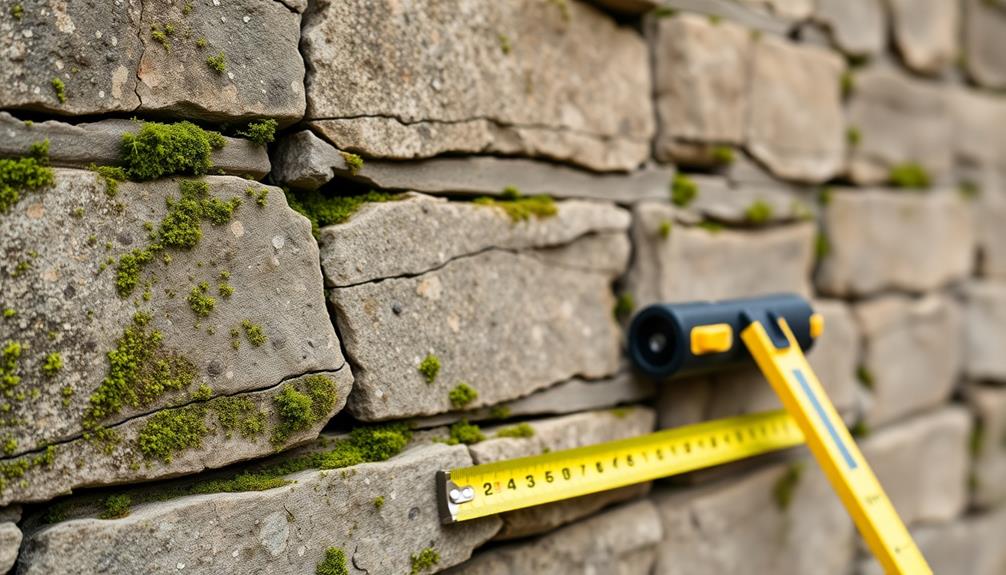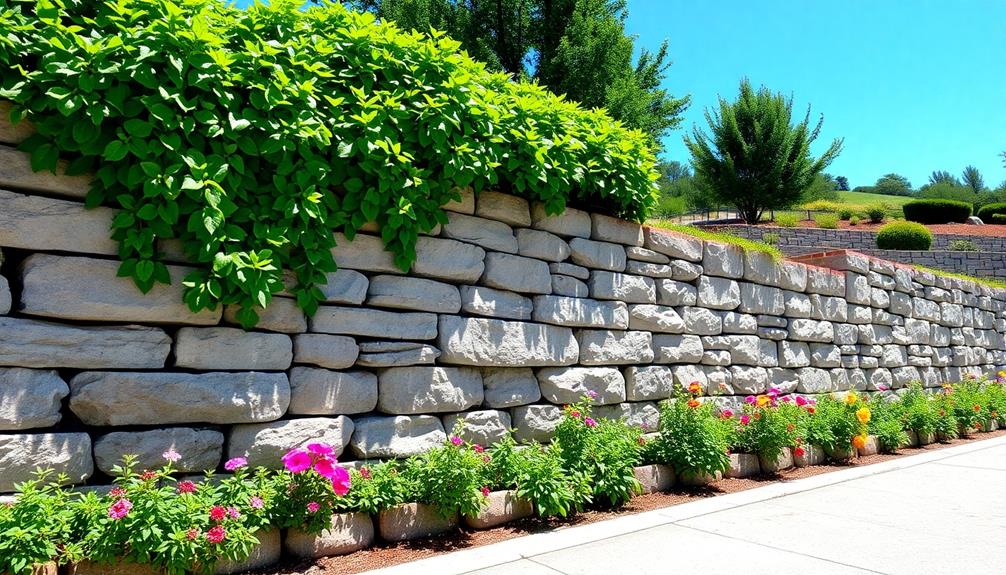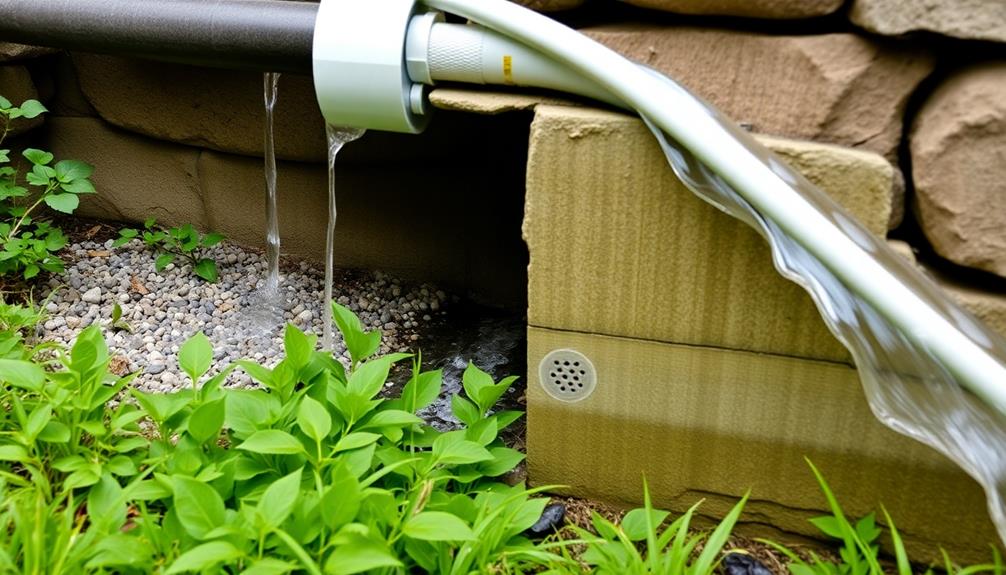Effective maintenance of retaining walls encompasses regular inspection, prompt repair, and proactive management. Visual checks for damage, structural integrity assessments, and addressing minor issues swiftly are vital components of a thorough maintenance strategy. These practices help identify potential problems early, prevent costly repairs, and guarantee the wall's longevity. Proper drainage system installation, including weep holes and appropriate backfill material selection, is indispensable for managing water pressure and preventing soil erosion. Surface water management further contributes to the wall's stability and performance. Implementing these best practices not only enhances safety but also increases property value. A deeper understanding of these maintenance techniques can dramatically improve the lifespan and effectiveness of retaining walls.
Table of Contents
ToggleWalls Contractor Highlights
- Conduct regular visual inspections for cracks, erosion, and drainage issues to identify problems early.
- Assess structural integrity periodically using non-destructive testing methods to ensure wall stability.
- Address minor issues promptly to prevent them from escalating into costly, major problems.
- Maintain proper drainage systems to prevent water buildup and potential damage to the wall.
- Remove invasive vegetation near the wall to protect its structure from root damage.
Regular Inspection and Repair

Regular inspection and repair form the cornerstone of effective retaining wall maintenance, encompassing a multi-faceted approach to confirm structural integrity and longevity.
For boulder and gabion retaining walls, staying ahead of potential issues during installation is pivotal for long-term performance. This process begins with thorough visual checks for signs of damage, including cracks, bulges, or water seepage, which can indicate potential structural issues if left unaddressed.
Following these visual assessments, a detailed structural integrity evaluation should be conducted, utilizing specialized tools and techniques to gauge the wall's overall stability and identify any areas of concern that may require immediate attention or ongoing monitoring.
Visual Checks for Damage
Conducting visual checks for damage is a key component of retaining wall maintenance. Regular inspections enable property owners to identify potential issues early, preventing costly repairs and ensuring the wall's longevity.
When performing these checks, focus on signs of structural compromise, such as cracks, bulges, or leaning sections. Additionally, examine the drainage system for clogs or inadequate water diversion, as proper drainage is essential for maintaining wall stability.
To effectively assess your retaining wall's condition, consider the following:
- Scrutinize the wall's surface for hairline cracks, which may indicate underlying stress or movement.
- Evaluate the soil at the base and top of the wall for erosion or settlement, potentially compromising the wall's integrity.
- Inspect vegetation growth near the wall, as invasive roots can cause structural damage over time.
Structural Integrity Assessment
The cornerstone of effective retaining wall maintenance lies in regular structural integrity assessments. These evaluations, typically conducted by qualified engineers or experienced contractors, involve a comprehensive thorough examination of the wall's load-bearing capacity, foundation stability, and overall structural soundness. During these assessments, professionals meticulously analyze key components, including reinforcement systems, drainage mechanisms, and soil conditions behind the wall.
Utilizing advanced techniques such as non-destructive testing, ground-penetrating radar, and stress analysis, experts can identify potential weaknesses or areas of concern that may not be apparent during visual inspections. These thorough exhaustive examinations enable property owners and maintenance teams to proactively address issues before they escalate into costly repairs or catastrophic failures.
The frequency of these assessments depends on various factors, including the wall's age, environmental conditions, and previous repair history. By adhering to a regular schedule of structural integrity assessments, stakeholders can guarantee ensure the longevity and safety of their retaining walls, mitigating risks associated with soil erosion, water damage, and structural degradation. This proactive approach not only safeguards investments but also contributes to the overall stability and aesthetic appeal of the surrounding landscape.
Addressing Minor Issues Promptly
A proactive approach to retaining wall maintenance involves addressing minor issues promptly through regular inspection and repair. By identifying and rectifying small problems early, property owners can prevent them from escalating into more significant, expensive issues. This strategy not only preserves the wall's structural integrity but also extends its lifespan, ensuring long-term stability and safety for the surrounding landscape.
Regular inspections should focus on detecting common issues such as:
- Fine cracks or fissures in the wall's surface, which may indicate underlying structural stress
- Signs of water seepage or drainage problems that could lead to erosion and instability
- Minor shifts or bulges in the wall's alignment, potentially signaling soil pressure concerns
When addressing these issues, it's essential to employ appropriate repair techniques tailored to the specific problem and wall type. For instance, small cracks may be sealed with specialized epoxy injections, while drainage issues might require the installation of additional weep holes or the clearing of existing drainage systems. By consistently implementing these maintenance practices, property owners can safeguard their investment and maintain the aesthetic appeal and functionality of their retaining walls for years to come.
Benefits

Proper maintenance of retaining walls yields numerous benefits that extend beyond mere structural integrity. For boulder walls, regular inspections guarantee that any shifting or damage is promptly addressed, maintaining their natural aesthetic and durability.
Regular upkeep can drastically increase property value by enhancing curb appeal and preventing costly repairs, while simultaneously improving safety measures by mitigating risks associated with wall failure or collapse. Additionally, well-maintained retaining walls contribute to improved landscape aesthetics and extend the overall lifespan of the structure, assuring long-term stability and functionality for years to come.
Increased Property Value
Consistently maintaining a retaining wall can greatly boost a property's value. Well-preserved retaining walls not only enhance the aesthetic appeal of a landscape but also demonstrate responsible property management. Potential buyers and appraisers often view well-maintained retaining walls as indicators of overall property care, which can positively influence their assessment of the property's worth.
A meticulously maintained retaining wall contributes to property value in several ways:
- Preventing soil erosion and maintaining landscape integrity
- Enhancing curb appeal through a clean, structurally sound appearance
- Reducing potential liability issues associated with wall failure
Proper upkeep of retaining walls also safeguards against costly repairs or replacements, which can substantially impact a property's financial valuation. Regular inspections, prompt addressing of minor issues, and professional maintenance all contribute to the longevity and functionality of these structures.
Enhanced Safety Measures
Enhanced safety measures derived from proper retaining wall maintenance offer substantial benefits to property owners and occupants. Regular inspections and timely repairs mitigate potential hazards associated with structural instability, soil erosion, and water damage. By addressing issues promptly, property owners can prevent catastrophic failures that could lead to injury or property damage, thereby ensuring the well-being of residents and visitors alike.
Implementing safety-focused maintenance practices, such as reinforcing drainage systems and monitoring wall integrity, drastically reduces the risk of sudden collapses or gradual deterioration. These measures not only protect individuals from physical harm but also safeguard valuable assets and infrastructure. Moreover, maintaining retaining walls in compliance with local building codes and safety standards demonstrates a commitment to community well-being and responsible property management.
Proactive maintenance also contributes to a safer overall environment by preventing soil erosion, controlling water runoff, and maintaining landscape stability. This all-inclusive approach to safety extends beyond the immediate vicinity of the retaining wall, fostering a sense of security throughout the property. By prioritizing enhanced safety measures through diligent maintenance, property owners create a more secure and desirable living or working space for all occupants.
Improved Landscape Aesthetics
Three key aesthetic benefits emerge from well-maintained retaining walls, elevating the overall landscape appeal. First, these structures provide a clean, organized appearance that enhances the property's visual harmony. Well-preserved walls create distinct levels and defined spaces, contributing to a more sophisticated outdoor design.
Second, properly maintained retaining walls serve as attractive backdrops for landscaping elements, allowing plants and decorative features to stand out against their uniform surfaces.
A well-maintained retaining wall can evoke:
- Pride in one's property and community
- Appreciation for the seamless integration of form and function
- Inspiration to further enhance outdoor living spaces
Lastly, retaining walls in good condition offer opportunities for customization and personalization. Homeowners can incorporate decorative elements, such as built-in planters or artistic finishes, to reflect their unique style. This attention to aesthetic detail not only improves the immediate surroundings but also contributes to the overall neighborhood's visual appeal. By investing in regular maintenance and occasional upgrades, property owners can guarantee their retaining walls continue to enhance the landscape's beauty while fulfilling their essential structural role.
Extended Wall Lifespan
Beyond aesthetic considerations, proper maintenance of retaining walls yields significant longevity benefits. By implementing a comprehensive care regimen, property owners can substantially extend the functional lifespan of these essential structures, ensuring their continued stability and performance for years to come. Regular inspections, coupled with prompt addressing of minor issues, prevent the escalation of problems that could otherwise lead to premature wall failure or costly repairs.
Proactive maintenance practices, such as cleaning drainage systems, repairing cracks, and reinforcing weak points, contribute to the wall's structural integrity over time. This approach not only safeguards the initial investment but also minimizes the need for extensive renovations or complete replacements in the future. Additionally, a well-maintained retaining wall continues to effectively manage soil erosion, protect against water damage, and maintain proper land grading throughout its extended lifespan.
Proper Drainage System Installation

A well-designed drainage system is essential for the longevity and stability of retaining walls. Proper installation encompasses three key elements: strategically placed weep holes, carefully selected backfill material, and effective surface water management. These components work in concert to prevent water accumulation, reduce hydrostatic pressure, and mitigate potential structural damage to the retaining wall.
| Drainage Element | Function | Installation Considerations |
|---|---|---|
| Weep Holes | Allow water to escape | Spacing, size, and placement |
| Backfill Material | Facilitates water movement | Gradation, compaction, and permeability |
| Surface Water Management | Directs water away from wall | Grading, swales, and catch basins |
Importance of Weep Holes
Proper drainage is essential for the longevity and stability of retaining walls, with weep holes playing a fundamental role in this system. These small openings, typically placed at regular intervals along the base of the wall, allow water to escape from behind the structure, preventing hydrostatic pressure buildup. By facilitating efficient water drainage, weep holes markedly reduce the risk of structural damage, soil erosion, and wall failure.
To emphasize the importance of weep holes, consider the following:
- Without proper drainage, your retaining wall may succumb to the relentless force of water, jeopardizing your property's safety and value.
- Implementing an effective weep hole system can extend your wall's lifespan by decades, saving you from costly repairs or replacements.
- A well-maintained drainage system, including functional weep holes, demonstrates your commitment to responsible property management and environmental stewardship.
When installing or maintaining weep holes, guarantee they remain unobstructed by debris or vegetation. Regular inspection and cleaning of these pivotal openings will help maintain their effectiveness. Additionally, consider incorporating a layer of gravel or drainage material behind the wall to further enhance water movement towards the weep holes, optimizing the overall drainage system's performance.
Backfill Material Selection
Selecting the right backfill material is essential for ensuring proper drainage and maintaining the structural integrity of a retaining wall. The ideal backfill should be well-graded, granular material that allows water to flow freely while providing adequate support. Crushed stone or gravel, typically ranging from 3/4 inch to 1-1/2 inches in size, is often recommended for its superior drainage properties and ability to compact effectively.
When choosing backfill, it's paramount to avoid materials that retain moisture, such as clay or organic soils, as these can lead to hydrostatic pressure buildup behind the wall. Instead, opt for materials with a low percentage of fines (particles smaller than 0.075 mm) to prevent clogging of drainage systems. Additionally, consider incorporating a layer of geotextile fabric between the native soil and backfill material to further enhance drainage and prevent soil migration.
This carefully selected backfill, when combined with properly installed weep holes and an extensive drainage system, forms a cohesive unit that effectively manages water flow and preserves the wall's longevity. By investing in quality backfill material, property owners can substantially reduce the risk of wall failure and costly repairs in the future.
Surface Water Management
Behind every successful retaining wall lies an effective surface water management system. Proper drainage installation is pivotal for maintaining the wall's structural integrity and longevity.
A well-designed system directs water away from the wall, preventing hydrostatic pressure buildup and soil erosion. This process involves strategically placing drainpipes, weep holes, and gravel layers to facilitate water movement.
To guarantee optimal surface water management, consider the following key elements:
- Implement a comprehensive grading plan that directs runoff away from the wall's base
- Install a perforated drainage pipe along the wall's length to collect and channel water
- Incorporate a layer of free-draining material behind the wall to prevent water accumulation
Professional installation of these components is essential for maximizing the retaining wall's performance. Regular inspections should be conducted to identify potential issues, such as clogged drains or erosion signs. Addressing these problems promptly can prevent more severe damage and costly repairs.
Walls Contractor FAQ
How Long Do Retaining Walls Typically Last Before Needing Replacement?
Fellow homeowners, retaining walls typically last 40-100 years, depending on materials and maintenance. Properly constructed concrete walls can endure a century, while timber walls may need replacement after 20-40 years. Regular inspections and care extend longevity.
Can Retaining Walls Be Painted or Stained for Aesthetic Purposes?
Many retaining walls can be painted or stained to enhance their appearance. This not only adds visual appeal but also allows you to personalize your outdoor space. Always use products specifically designed for the wall's material for best results.
Are There Specific Plants That Can Help Stabilize Retaining Walls?
Many plants can help stabilize retaining walls. Consider using deep-rooted species like creeping juniper, pachysandra, or ornamental grasses. These not only enhance aesthetics but also prevent soil erosion and provide additional support to the structure.
What Role Does Soil Type Play in Retaining Wall Maintenance?
Soil type considerably impacts retaining wall maintenance. Different soils have varying drainage properties and expansion rates, affecting wall stability. Understanding your soil composition helps us tailor maintenance strategies, ensuring the longevity and safety of our retaining structures.
How Often Should Retaining Wall Anchors Be Checked and Adjusted?
Retaining wall anchors should be inspected annually and after significant weather events. Adjustments may be necessary every 3-5 years, depending on soil conditions and wall performance. Regular checks maintain optimal stability and longevity for our community's structures.







